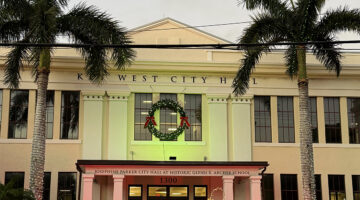Affordable AIDS housing to increase in Key West
BY PRU SOWERS
KONK LIFE STAFF WRITER
“Marty’s Place,” the 16-unit housing development on Bertha Street, is about to get a complete
makeover, substantially increasing the amount of low-cost rental housing for Key West residents living
with HIV/AIDS.
The cottage-style development, operated by AH Monroe, formerly AIDS Help, will be demolished to
make way for four, three-story buildings surrounding a central courtyard. The number of apartments on
the site will be increased from 16 to 47, serving the same constituency, and an administration building
will also be built on the parcel, which borders Bertha, Venetia and Dennis streets near Key West High
School. Key West City Commissioners unanimously approved the major development plan for the
project at their Jan. 2 meeting.
Lori Thompson, development specialist for architect Trepanier & Associates, said the project will be
federally funded and provide 47 one-bedroom apartments ranging from 400 to 600 square feet. There
will be a mix of independent and assisted living apartments and a health clinic will be housed in the
building.
“Unfortunately, [Marty’s Place apartments] are in a very poor condition and they’re not good candidates
for renovation,” Thompson said.
Marty’s Place is an independent living housing development and was the first housing complex
purchased by AIDS Help in the late 1980’s. Since then, the non-profit organization’s housing portfolio
has grown to include Poinciana Royale, a 50-unit apartment building in Poinciana Plaza; Seebol Place
Project, a 14-unit independent living development; 11 units at Harvey House; and the five-unit
McCarthy-Rogers Residence. All of the properties provide low cost independent living apartments for
local residents with HIV/AIDS.
But that is the problem, according to Scott Pridgen, executive director of AH Monroe. Few of the AH
Monroe rental units are handicapped accessible or provide services to people needing more help.
“We’re seeing our demographic are needing as they age, as their condition worsens, they are needing
more of that handicapped, ADA [Americans with Disabilities Act] unit. This [new development] will give
us 12 ADA units but all of the units will be handicapped accessible,” Pridgen said.
The plan calls for 16 parking spaces, two more than required under city code. However, Commissioner
Greg Davila was concerned that with 47 tenants, more than 16 will own cars. And two residents on
Dennis Street said they were in favor of the project but also concerned about parking that needs to
accommodate both the residents and staff.
“It’s going to be very hard for anyone to go against an AIDS Health project. But my concern is for the
neighborhood, tripling the size of what’s there now and having 16 off-street parking spaces,” Davila said.
Commissioner Sam Kaufman, before voting with his colleagues to approve the major development plan,
said he believed AH Monroe would work with concerned neighbors to solve any problems that might
arise.
“I know that’s not perfect,” Kaufman said. “But I know these are good people.”
In other construction news, the Florida Department of Transportation (DOT) has pushed forward the
start date to install five pedestrian protection signal systems along North Roosevelt Boulevard.
Construction will now begin Feb. 22, instead of the planned September start date. It should take eight
months to complete.
“But hopefully, it’s not going to take eight months,” said assistant city manager Greg Veliz.
Two pedestrian deaths and several accidents have occurred at the DOT-designed crosswalks on the
boulevard since the repaving of the street was completed in 2015. City officials and former Key West
Police Chief Donie Lee made multiple urgent requests that more powerful signal systems be installed to
alert drivers that people are crossing the busy street.
The five crosswalks along North Roosevelt are located near the 24 North Hotel, near Capital Bank, the
Key Plaza Shopping Plaza, between 7 th Street and Hilton Haven Road, and west of 3 rd Street.
The new signal system will use a mast extended across both inbound and outbound lanes of North
Roosevelt. The mast will have signal lights attached that will remain dark unless a pedestrian pushes the
activation button. Then, motorists will see a flashing yellow light for a few seconds, followed by a steady
yellow for a few more seconds to alert them they will have to stop. Then a double solid red light will
follow, requiring motorists to stop at the stop line bar. The pedestrian will see a flashing walk signal with
a countdown timer, allowing them to get across the road.






No Comment